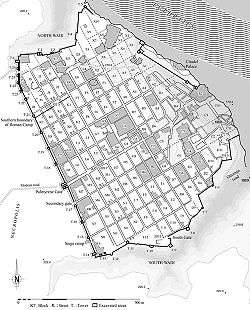Siege of Dura Europos (256)
| Siege of Dura Europos (256) | |||||||||
|---|---|---|---|---|---|---|---|---|---|
| Part of the Roman-Persian wars | |||||||||
 Map of Dura-Europos in Roman times. | |||||||||
| |||||||||
| Belligerents | |||||||||
| Sassanid Empire | Roman Empire | ||||||||
| Commanders and leaders | |||||||||
| Shapur I | |||||||||
| Strength | |||||||||
| unknown | unknown | ||||||||
The Siege of Dura Europos took place when the Sassanids under Shapur I besieged the Roman city of Dura-Europos in 256 after capturing Antioch.
The siege was notable for the early use of chemical weapons by the attacking Persian army. During the siege the attackers dug several underground shaft mines under the city walls. The Romans dug tunnels to reach the mines and fight the diggers underground. In one such tunnel, when the Romans broke through into the Sassanid tunnel the tunnelers ignited a mixture of sulfur and pitch, producing a cloud of sulfur dioxide which killed twenty Roman soldiers. Archaeologists excavated the scene in the 1930s. In 2009 tests showed the presence of sulfur dioxide inside the tunnel.[1][2][3]
References
- ↑ “Death Underground: Gas Warfare at Dura-Europos,” Current Archaeology, November 26, 2009 (online feature) http://www.archaeology.co.uk/cwa/world-news/death-underground-gas-warfare-at-dura-europos.htm (accessed October 3, 2014)
- ↑ Samir S. Patel, “Early Chemical Warfare – Dura-Europos, Syria,” Archaeology, Vol. 63, No. 1, January/February 2010, http://www.archaeology.org/1001/topten/syria.html (accessed October 3, 2014)
- ↑ Stephanie Pappas, “Buried Soldiers May Be Victims of Ancient Chemical Weapon,” LiveScience, March 8, 2011, http://www.livescience.com/13113-ancient-chemical-warfare-romans-persians.html (accessed October 3, 2014).
This article is issued from Wikipedia - version of the 9/11/2016. The text is available under the Creative Commons Attribution/Share Alike but additional terms may apply for the media files.